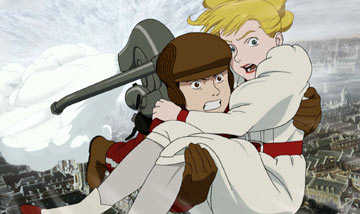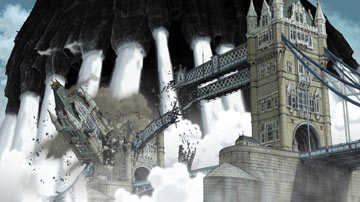Steamboy


Katsuhiro Otomo's Steamboy arrives nearly twenty years after Akira, the film that opened America's eyes to anime. Akira was groundbreaking in its melding of sophisticated storytelling and amazing visuals. Americans saw that animation could be much more than cartoons, and began exploring what these possibilities were overseas. In the intervening years, Otomo has contributed to some smaller projects (Memories), but Steamboy is his first full-length film. He spent nearly a decade on Steamboy, and unfortunately, while the visuals are stunning, there needs to be a lot more work on the story. The good news is that there are two versions, subtitled (which is twenty minutes longer) and dubbed, the bad news is that this is a review of the dubbed one (STOP DUBBING FILMS).
The look of Steamboy is the real treat. It is pure visual eye candy. Steamboy takes place in the late 1800s, as England is beginning to industrialize. Otomo and his artists used a combination of hand-drawn and computer animation to bring this world to life. The entire look is one of retro-science fiction, with huge, steam-powered driving and flying machines. Lord Steam and his son Eddie created the steam ball, a marvelous invention that adds a huge amount of power to whatever it is connected to. Because this is such a powerful device, many want to use it for weaponry. The Steams send it to Eddie's son Ray, who must deliver it to Robert Stephenson. As soon as Ray gets it, people begin chasing him. He has no idea who to trust, especially when his father and grandfather reappear. His father now looks like a half-mechanical monster, while his grandfather seems insane. Eddie, along with the O'Hara Foundation wants to use the steam ball to power something he calls the Steam Castle at a large science exposition in London. Meanwhile, Stephenson and the British authorities want to stop him. That is the entire story. It is remarkably convoluted for something so flimsy, and is populated with razor-thin characterizations.
Otomo wrote the story with Sadayuki Murai (Millennium Actress, Perfect Blue), and any efforts to pry into it will be rewarded with frustration. The two set up a series of intrigues and double-crosses, but fail to explain motives and reasons. It all boils down to good guy versus bad guy, which isn't necessarily a bad thing, but when Otomo is reaching for higher aspirations, something this simple does not work. Comparing the story and characters of Steamboy to Akira makes it seem even worse. Akira's characters were incredibly complex. Here, it's easy to predict what each person will do after listening to them for a few minutes. Steamboy feels like the middle chapter of some huge epic. Unfortunately, this is not the case. After watching, one feels that something is missing from the story.
So the best thing to do is ignore the story and just feast on the visuals. Strange machines sprung from Otomo's mind work their way across the screen. London is animated in a marvelously complex manner, full of detail and flourish. A battle lasting nearly half an hour anchors the latter portion of the film, where Steam City rises into the sky, and Ray flies, Rocketeer-like trying to come to the rescue. It's a wonderful sight to behold, and Otomo gets extremely detailed as he lays waste to London. Glass shatters into millions of shards, each one reflecting images around it. One can feel the wonder of the bystanders as they watch Steam City rise into the air. But a half hour battle is far too long, especially when there's no substance to return to when the battle is over.